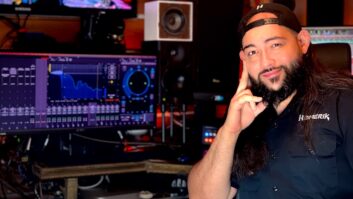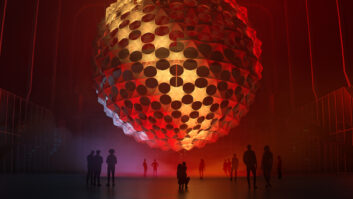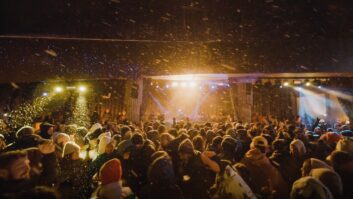
Since 2011, sneaker and apparel company, Converse Inc. has been giving back to youth culture with its Converse Rubber Tracks program, offering young bands free studio time in permanent and pop-up facilities around the world.
“The idea of Converse Rubber Tracks initially came about when we realized the brand’s biggest supporters over the years are artists, bands and musicians,” explains Jed Lewis, Global Music Marketing Director at Converse. “As a brand, we wanted to give back to these artists by creating useful opportunities for them to make their art—no strings attached.”
Through Converse Rubber Tracks, artists are given a full day of free studio time in a professional facility. The program built its first permanent studio four years ago in Brooklyn, and has another facility in Sao Paulo, Brazil.
Then, just last month, Converse Rubber Tracks went online with its new permanent studio, built into the new Converse headquarters in Boston. Designed by top acoustician Francis Manzella of FM Design, with exterior architectural design by Jennifer Carpenter, the facility is situated atop a recently opened Converse retail store on Lovejoy Wharf, where all things Converse now blend into a popular historic urban district.

“They planned that the studio would sit on top of the retail store as kind of a crown,” Manzella says. “They had set parameters about what the outside would look like, so we knew going in that there were going to be external windows; the control room and the live room have north-facing windows with views over the wharf.”
Manzella was asked to employ a similar setup at the Brooklyn facility; he used his trademark elegant solutions to create rooms that mirror the workflow of Brooklyn, but take the Boston building’s location, shape and materials into account.
“The studio is adjacent to a very busy street,” he says. “There’s a public promenade where people congregate. There are trucks and buses flying by all the time, and we knew we would be above a retail establishment. We had to do the right thing as far as isolation, so we have proper floated floors, complete room-within-a-room construction.
“We actually achieved amazing isolation,” Manzella continues. “I’ve been there three times since it was finished, and I heard no traffic—not a peep from the outside world—and that was when we were doing listening tests to identify internal noises and eliminate them. So you know we were listening to dead-quiet spaces very carefully.”

The completed control room at Converse Rubber Tracks in Boston measures 360 square feet, while the live room is 445 square feet, including a drum alcove, called the “dead niche,” in the back corner of the room. “That is a more trapped area with the soffit lowered, whereas the main area has those high ceilings with diffusers, and a lot of reflective surfaces with the glass windows and hard floors,” Manzella says.
“Both Brooklyn and Boston have a very comfortable work environment,” says Brad Worrell, studio manager at Converse Rubber Tracks in Brooklyn. “That’s important when you’re working with young bands, because you don’t want them to be intimidated by the space.”
Worrell—who was instrumental in building the Boston facility—says that during Converse Rubber Tracks’ pop-up sessions, as well as within their permanent studios, Converse looks for similar qualities: mid-size rooms with quality, but not overly slick, designs to set young bands at ease, and equipment that includes extensive instruments and backline, and offers a straightforward workflow.
“We go for an old-school input chain,” he says. “We almost always work in places with analog consoles. We also always record to Pro Tools so the artists can work inside the box and take something with them.”
Reliability being of the essence on a one-day session, Worrell selected a Rupert Neve Designs 5088 console for the Boston studio, along with a complement of familiar outboard gear and microphones, and Ocean Way HR2 main monitors. “We also have the HR2s in Brooklyn,” he says. “Those are the only large-format monitors that I’ve worked on that I felt like I could also mix on.”
The studio engineer at Converse Rubber Tracks in Boston is Matt Carlson, who has a background as a drummer as well as behind the glass, so he feels a connection to the musicians he works with from 11 a.m. to 7 p.m., five days a week.

“Because this is an educational moment for these newer bands, we try to provide the best experience from the moment they’re selected,” Carlson says. “The studio team begins advancing at least two weeks before to align on artist goals and determine what’s feasible during the day-long session. We provide advice that may help prepare them for their day in the studio.
“On the day of the actual session, we use the earlier half of the morning for the artists to sit one-on-one with the engineer and/or producer discussing how everything will run. From there, we get sounds quickly and really hit the ground running. The full team works with them throughout the typical eight-hour session. With full bands, for example, we often encourage them to record basics all together.
“We are constantly surprised at how prepared many of these new bands are when they get to the studio,” Carlson continues. “Bands may come in looking to record two or three songs and end up recording four or five. It’s great to be able to help them bring their vision to life.”
Musicians who are interested in applying for studio time: visit converse-music.com/rubbertracks.







